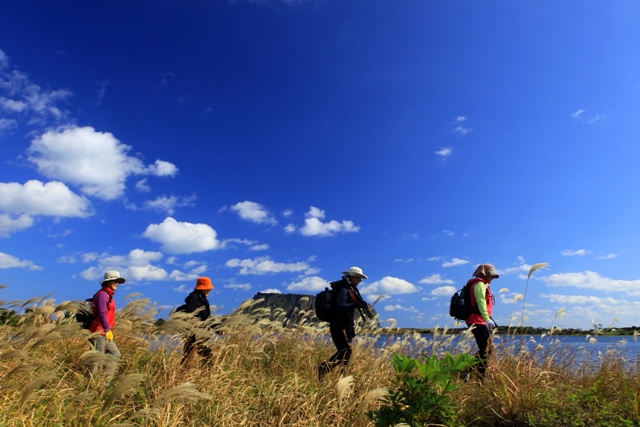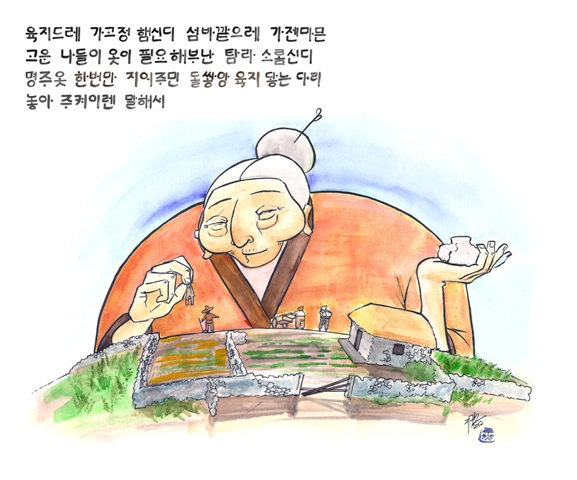|
| |
 |
|
| ▲ Walkers are invigorated after walking Jeju's Olle system. Photo courtesy Jeju Special Self-Governing Province |
According to the myth of “Seolmundae Halmang,” the creator goddess of Jeju Island was so tall that she could stretch her feet to Gwantaldo Islet in the ocean between Jeju and the mainland, while her head would rest on the pillow of Mt. Hallasan.
Upon deciding to create Jeju Island she gathered up earth in her skirt and carried it bit by bit. Where the earth fell the island’s 360 oreum, or volcanic cones, were formed. Then, having found that Hallasan had been fashioned too high, she plucked off its crown and threw it down, creating Mt. Sanbangsan, in Sagye-ri, Andeok-myeon, one of Jeju’s most popular scenic spots.
“Halmang” means grandmother in Jeju dialect (and can also signal divinity) and in Korea there is a popular belief that "grandmother’s hands are healing hands." When a child has a stomachache or headache, the child’s grandmother puts their head on her lap and rubs their stomach in a clockwise direction, incanting warmly “grandmother’s hands are healing hands.” The child feels the warmth of her hands and the pain disappears like magic.
It is unclear why the grandmother’s hands contain such magic, casting a spell over the child almost, but it is presumed to be the power of suggestion, or the placebo effect in medical terms.
| |
 |
|
| ▲ Seolmundae Halmang and her caring grandmother hands. Image courtesy Lucas Green |
The healing hands of Jeju Olle
While Jeju Olle is a system of 21 trail courses all around Jeju and adjacent islands, walkers along it also arguably receive the healing hands of Seolmundae Halmang.
The Olle system is often metaphorically compared to Seolmundae Halmang’s caressing hands as she heals broken hearts and weary city souls as they walk.
Olle is Jeju dialect for a path betwixt shoulder-height stone walls, running from the street to someone’s home.
Wounds both large and small in the heart and soul, collateral damage in a fiercely competitive society, heal unbeknownst to the sufferer as feelings of peace and contentedness rise from within, fostered by a newfound vigour and zest.
This is not hyperbole, as the Olle courses from 7.5 to 23 k.m., running alongside Jeju’s fresh seas, up its flower-dotted oreum, or penetrating its local villages, are perfect catalysts for internal transformation.
They also follow forest trails hiding medicinal herbs, with some being called “a remedy without side effects,” a therapeutic power increasingly appreciated.
It has been said that walking on a forest trail improves cognitive ability by 3 percent compared to city streets, while negative feelings of tension, fatigue and depression decrease 71 percent. Phytoncide and anion are released by trees and increased alpha waves in the brain foster a feeling of stability.
The healing benefits of woodlands have been confirmed in numerous studies, and when forest healing has been tried on patients recovering from surgery after breast cancer, white blood cells increased 39 percent. Similarly positive results were found when children with asthma went into forests and pulmonary functions improved by 5 percent. Inflammation also decreased by 10 percent while there was a 34 percent improvement in atopic skin conditions.
In short, woodland trails are places of healing where immunity and well-being are boosted.
In addition to all of this, Jeju Olle naturally attracts people seeking to open their minds and find avenues of communication.
Local press recently reported the case of a corporate executive who brought his son to Jeju for a heart-to-heart while walking Jeju Olle before conscription into the military. The father and son were able to tear down their internal mental barriers while walking two courses a day over a week in deep conversation.
There was also the case of a city dweller who was able to transform his internal chaos into glorious resolution step by step along the Olle. He cleared his mind and plumbed the depths of his unconscious — or others might say Mother Nature gave him a helping hand.
All year round there is steady growth in the number of walkers on Jeju Olle, and there is increasing fascination in this rapidly iconic trail. The Jeju Olle Foundation states that just 3,000 visitors walked the trails in 2007 when the trails were first developed, and quickly increased 10-fold to 30,000 by the next year. By 2009 the figures had reached 250,000, then 780,000 in 2010, a million in 2011 and then 1.2 million last year.
This growth is without even mentioning the incredible explosion in Olle-inspired trails all around the Korean mainland and world. The Olle brand is now a recognizable Jeju export, even building solidarity with far-flung communities around the globe.
In Kyushu, Japan, there are now four courses modeled on Jeju Olle, even using the same ribbons, arrows and “ganse” symbol, which represents a Jeju pony and means laziness in Jeju dialect.
Jeju Olle has also established “sister” trail status with courses in Europe, North America, and Asia since 2010. Last October, Jeju Olle and "Lebanon Mountain Trail" became the sixth such “Friendship Trail” and there too you can see the “ganse” symbol and information board familiar from Jeju Olle on LMT Route 21. To reciprocate, Jeju Olle 9 includes an information board for the Lebanese trail.
The healing hands of “Seolmundae Halmang” are thus reaching across the world, symbolizing the healing power of Mother Nature, helping turn these world-class trails into renowned courses of inner healing and well-being.
|





















